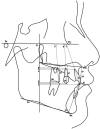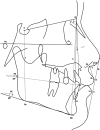Treatment effects of modified miniscrew-assisted rapid palatal expander and rapid palatal expander for molar distalization
- PMID: 39799973
- PMCID: PMC11842109
- DOI: 10.2319/042024-308.1
Treatment effects of modified miniscrew-assisted rapid palatal expander and rapid palatal expander for molar distalization
Abstract
Objectives: To evaluate the treatment effects of the modified miniscrew-assisted rapid palatal expander (MARPE) and rapid palatal expander (RPE) with distalizers in patients with Class II malocclusion and maxillary crowding.
Materials and methods: The sample comprised 28 skeletal Class I adolescents with dental Class II malocclusion and maxillary crowding of >4 mm who received nonextraction treatment. Fourteen patients were treated with a modified MARPE with distalizer (MMD), while another 14 patients were treated with a modified RPE with distalizer (MRD). Lateral cephalograms and study casts were taken at pretreatment (T1) and after expansion, distalization, and at the initiation of alignment (T2). Twenty-nine variables were compared using a Bonferroni-adjusted independent t-test and a Mann-Whitney U-test.
Results: From T1 to T2, the maxillary first molars in the MMD group exhibited distalization of 3.0 mm and 2.4 mm at the crown and root (P < .001) compared with 2.1 mm and 1.4 mm in the MRD group. However, no significant difference was found in distalization between the two groups. The first molars in the MRD group showed a significantly greater distal tipping of 2.8° than in the MMD group (P < .001).
Conclusions: Although both groups showed maxillary molar distalization, the MMD group had no distal molar tipping, while there was significant molar tipping in the MRD group. It can be useful to plan nonextraction treatment with maxillary expansion and molar distalization in patients with Class II malocclusion and a narrow maxillary arch.
Keywords: Class II; Crowding; Modified MARPE with distalizer; Molar distalization; Nonextraction.
© 2025 by The EH Angle Education and Research Foundation, Inc.
Figures





References
-
- Tollaro I, Baccetti T, Franchi L, Tanasescu CD. Role of posterior transverse interarch discrepancy in Class II, division 1 malocclusion during the mixed dentition phase. Am J Orthod Dentofacial Orthop. 1996;110:417–422. - PubMed
-
- Franchi L, Baccetti T. Transverse maxillary deficiency in Class II and Class III malocclusions: a cephalometric and morphometric study on postero-anterior films. Orthod Craniofac Res. 2005;8:21–28. - PubMed
-
- Starnbach H, Bayne D, Cleall J, Subtelny JD. Facioskeletal and dental changes resulting from rapid maxillary expansion. Angle Orthod. 1966;36:152–164. - PubMed
-
- Wertz RA. Skeletal and dental changes accompanying rapid midpalatal suture opening. Am J Orthod. 1970;58:41–66. - PubMed
MeSH terms
LinkOut - more resources
Full Text Sources

